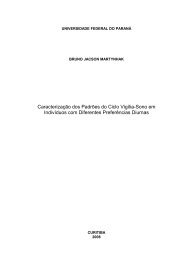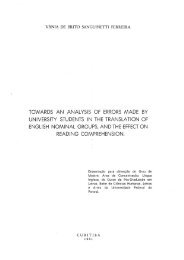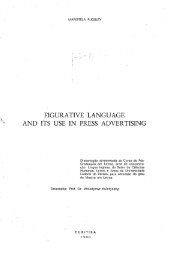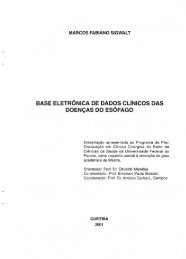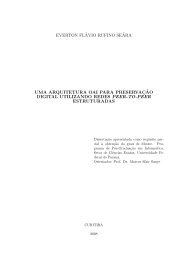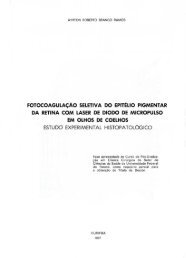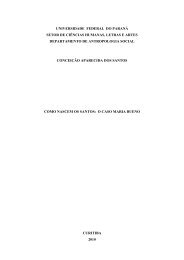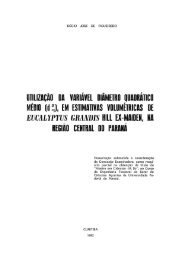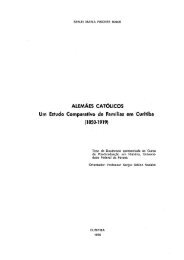Disserta??o de Mestrado - Tha?s Gama.pdf - DSpace ...
Disserta??o de Mestrado - Tha?s Gama.pdf - DSpace ...
Disserta??o de Mestrado - Tha?s Gama.pdf - DSpace ...
You also want an ePaper? Increase the reach of your titles
YUMPU automatically turns print PDFs into web optimized ePapers that Google loves.
COMPARATIVE STUDY OF PHYSICO-CHEMICAL ASPECTS AMOUNG THE<br />
NATIVE PINHÃO AND ONE ARISING FROM CONTROL ARAUCARIAS<br />
POLINIZATION PROCESS OF Araucaria angustifolia AND THEIR IMPLICATIONS<br />
ON THE THERMIC TREATMENTS<br />
The Araucaria angustifolia (Bertoloni) Otto Kuntze is called Brazilian pine in the popular<br />
sense, being the unique native specie in Brazil that produces seeds. The typical yellow-red<br />
pinhão is knowed as growed and mature seed which is used as food to animals and people.<br />
The seed is mature and can be harvest during april to may. The objective was to i<strong>de</strong>ntify the<br />
pinhão constitution modifications resulted from the manual polinization process (PP) in<br />
comparison the native pinhão (NP), assuring to people good information about the consume<br />
of thermically heated pinhão. The samples was divi<strong>de</strong>d in three groups: one part in nature<br />
(control sample), the second sample was cooked by hot water immersion at 100 o C for 30<br />
minutes and a third part was toasted at 210 o C for 20 minutes. The physic-chemicals<br />
characteristics of each group was analyzed in terms the contents of moisture, ash, dietary<br />
fibers, lipids, proteins, carbohydrates, total starch, colorimetry, water activity and scattering<br />
electronic microscopy. Experimental planning was entirely casual consi<strong>de</strong>ring six<br />
treatments (PN1, PN2, PN3, PP1, PP2 e PP3) with three repetitions each sample, permitting<br />
to confront the statistical difference between cru<strong>de</strong>, cooked and toasted pinhão in the NP<br />
group and FP group separately and together. In most of results toasted pinhão was similar<br />
to cru<strong>de</strong> one in respect of macronutrients. The cooked pinhão was presented <strong>de</strong>pletion of<br />
some hydrosolubles compounds. In the PP-Toasted and PP-Cru<strong>de</strong> was found high<br />
concentration of lipids and fibers. The studied pinhões was classified as energetic food ou<br />
high food concerned their high content of dietary fibers verified in all samples. In the<br />
contents of proteins and carbohydrates were observed <strong>de</strong>pletion with thermic treatments<br />
application. With the colorimetric method the analyses were possible to check color<br />
characteristics with the different types of treatments applicated and its influence in the<br />
samples darkness. In this sense, the starch analyses were essential for the results<br />
un<strong>de</strong>rstanding. The starch micrographics showed big size and format difference between<br />
the types of particles of native pinhão and after thermics treatments (cooked and toasted).<br />
Consi<strong>de</strong>ring the high moisture and water activity <strong>de</strong>tected is strong recommen<strong>de</strong>d the<br />
continuity of the study of these parameters related them to microbiological analyses.<br />
Key-Words: native pinhão, manual polinization pinhão, cook, toast and cru<strong>de</strong>.<br />
xiv



